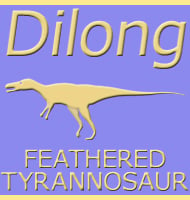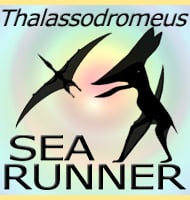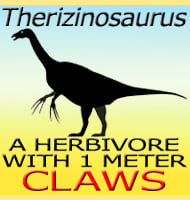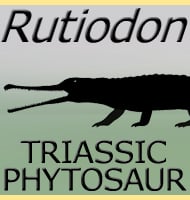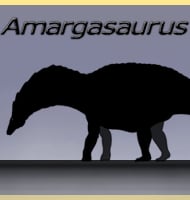Long before the age of whales and sharks, the oceans were ruled by a group of sleek, powerful marine reptiles known as ichthyosaurs.
These “fish lizards” were the ultimate underwater predators of the Mesozoic Era, dominating the seas for over 150 million years.
With their streamlined bodies, massive eyes for deep-sea hunting, and a striking resemblance to modern dolphins, ichthyosaurs were marvels of evolution.
But these marine giants were more than just ancient hunters. From ichthyosaurs the size of speedboats to species that gave live birth, they were a diverse and fascinating group of creatures that rewrote the rulebook on marine life.
Ichthyosaurs are also surprisingly diverse, adapting a variety of different hunting methods for various prey.
10 - Temnodontosaurus
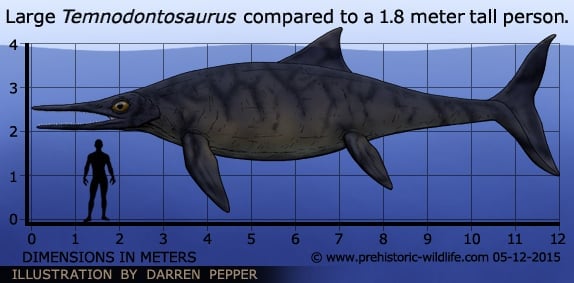
We start off with Temnodontosaurus, a large genus of ichthyosaur that lived during the Early Jurassic.
Temnodontosaurus is noted for having fairly blunt and robust teeth, which seem to indicate that Temnodontosaurus specialised in eating armoured prey.
Further to this, broken shells from ammonites have been found in association with the stomach contents of specimens of Temnodontosaurus, further supporting that Temnodontosaurus was a specialised predator of tough prey like ammonites.
Temnodontosaurus also seems to have dived deep to hunt for prey, as indicated by the large eyes of Temnodontosaurus which could be as much as twenty centimetres in diameter.
In marine animals large eyes only seem to develop in animals that spend time in the dark depths of the ocean where very little sunlight from the surface penetrates.
9 - Eurhinosaurus
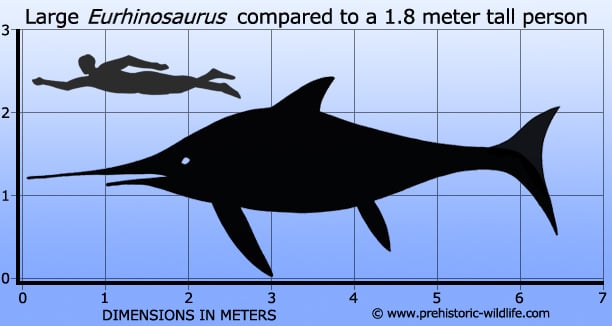
At least in terms of appearance, Eurhinosaurus was half ichthyosaur, half swordfish.
The greatly extended snout of Eurhinosaurus may have been used in a similar manner to how a swordfish uses its elongated snout.
This would involve swimming up to a shoal of fish and then thrashing its head about, swiping the fish with the long snout like a sword.
This would not actually cut up the fish, but it would stun and injure the fish so that they could swim away very quickly, making them easy pickings.
Eurhinosaurus was not the only ichthyosaur to develop such a specialised snout, but it had one of the most fish like bodies, indicating that it may have been one of the fastest swimming of its kind.
8- Besanosaurus
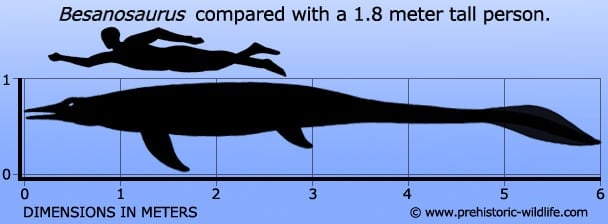
Living in the Triassic, Besanosaurus was a primitive ichthyosaur but one that had already gone down a specialised form of hunting.
Clue to this are the eyes which at twenty centimetres across would have been perfectly suited to seeing in the gloomy depths of the ocean where the sunlight did not penetrate.
At least one specimen of Besanosaurus also shows us that ichthyosaurs were capable of giving birth to several live young at a time.
7 - Platypterygius
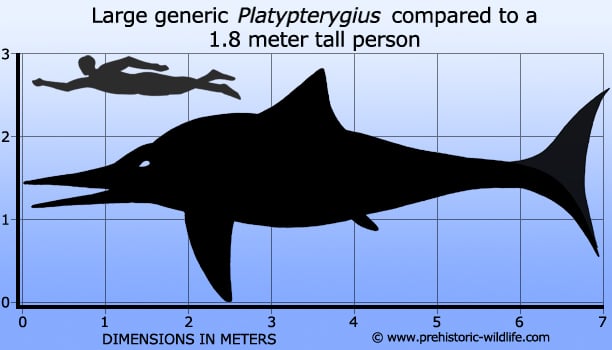
It cannot be denied that the ichthyosaurs were one of the success stories of the Mesozoic, though as we already know they too went extinct.
With their origins at least as far back as the early Triassic, the ichthyosaurs survived well all the way to the end of the Cenomanian.
It was at this point that an anoxic event took place which caused a severe drop in oceanic oxygen levels, which in turn caused massive amounts of fish and other prey animals to die out.
As air breathers the ichthyosaurs were not primarily affected by this oxygen drop, but the resulting lack of prey animals meant that there was no longer enough food to feed them.
The genus Platypterygius is one of the few genera of ichthyosaurs that we know about that actually survived past this oceanic mass extinction.
The reason for this may be down to the adaptations for fast swimming that are some of the most highly advanced of any ichthyosaur.
Being able to swim more quickly meant that Platypterygius would have been able to hunt a greater range of fish, and so they managed to survive past the main extinction, until eventually disappearing themselves in the Turonian period of the Late Cretaceous.
6 - Ophthalmosaurus
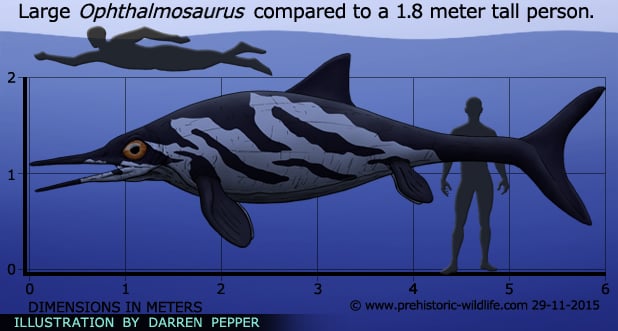
Since appearing in a key role in the series Walking With Dinosaurs, Ophthalmosaurus has become one of the popular genera of ichthyosaurs.
claiAside from being a popular genus, Ophthalmosaurus is also a very interesting genus.
Fossilised bones of Ophthalmosaurus show decompression damage caused by sudden diving and surfacing to and from deep depths, and like with the aforementioned Temnodontosaurus, Ophthalmosaurus had very large eyes for capturing low light in the dark depths (Ophthalmosaurus actually means ’eye lizard).
Combined with tightly packed vertebrae to prevent pockets of gas forming and a very streamlined body, this all paints a picture of an ichthyosaur that would dive very deep, very quick, snatch up soft bodied prey like deep sea squid, and then quickly swim up to the surface before running out of air.
Ophthalmosaurus is also one of the genera that shows in explicit detail not only how ichthyosaurs gave birth to live young, but how many young could be born at one time.
5 - Cartorhynchus
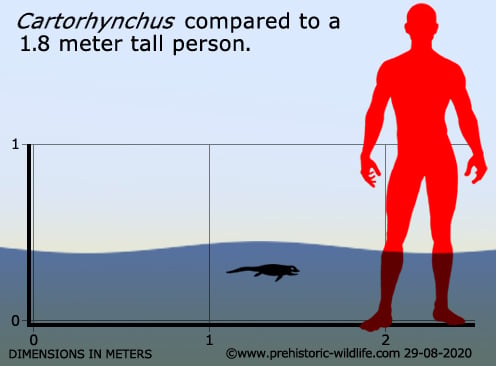
Named in 2015, Cartorhynchus has been one of the most standout important discoveries concerning our understanding of how ichthyosaurs evolved.
Classed as an ichthyosauroid, Cartorhynchus was a small semi-aquatic reptile that hunted for fish and other aquatic creatures in shallow waters.
Cartorhynchus had a broad tail, wide skull and well developed eyes, and already the legs were forming into paddles for steering while swimming.
From forms such as this, the ichthyosaurs would eventually and rather quickly make the full transition to life in the seas and oceans.
4 - Mixosaurus
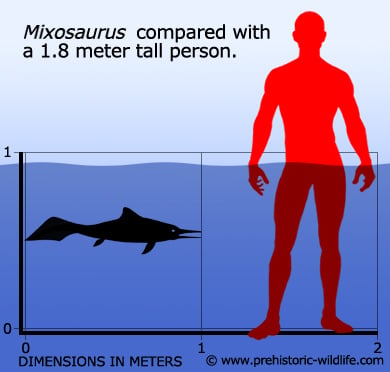
Study of Mixosaurus has been very important to our study of how the ichthyosaurs evolved over the Triassic.
This is because Mixosaurus has a mix (the clue is in the name!) of both primitive and advanced features.
In turn this has allowed for a greater understanding of how the ichthyosaurs went from reptiles that adapted themselves for swimming, to resembling open water fish.
3 - Ichthyosaurus
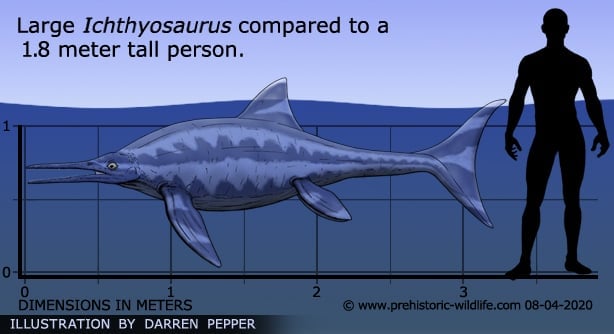
This is the genus that started it all, first described in 1821, Ichthyosaurus was used to establish the Ichthyosauria which is why all marine reptiles similar to ichthyosaurus in their lineage are called ichthyosaurs.
Because the study of ichthyosaurs as well as the wider science of palaeontology was still in its infancy during the early nineteenth century, Ichthyosaurus ended up becoming what is known as a ‘wastebasket taxon’.
What this means is that any ichthyosaur remains that vaguely resemble (and sometimes not even closely resembling) the Ichthyosaurus type fossils were automatically identified and described as Ichthyosaurus without much further thought as to if they actually belong.
This led to a great many species being named for Ichthyosaurus which simply should not have been done, and today at the time of writing there are only four species of Ichthyosaurus recognised.
To be fair it can be difficult to tell one genus of ichthyosaur from another, even with modern techniques and some two hundred years of study into ichthyosaurs behind us.
Still, Ichthyosaurus has been a poster animal for the prehistoric oceans for many generations now, and remains one of the most popular prehistoric animals in popular culture for this reason.
2 - Thalattoarchon
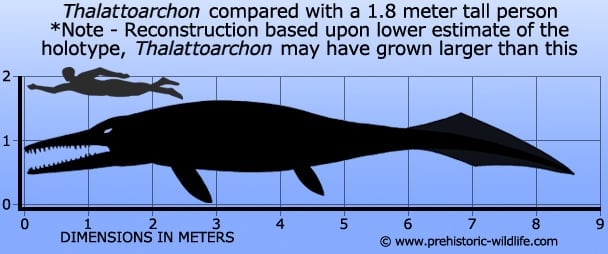
During the Triassic the ichthyosaurs quickly diversified into many ecological niches, and while the majority became hunters of fish and squid, there was one notable exception.
Thalattoarchon went down the route of becoming an apex predator, hunting other large marine organisms, including other ichthyosaurs.
To do this Thalattoarchon had large robust jaws in which grew large teeth with cutting edges, perfect for cutting through the flesh of other marine reptiles.
Growing at least eight and a half meters in length Thalattoarchon was big, but as we shall now see it was not even close to being the biggest ichthyosaur.
1 - Shastasaurus
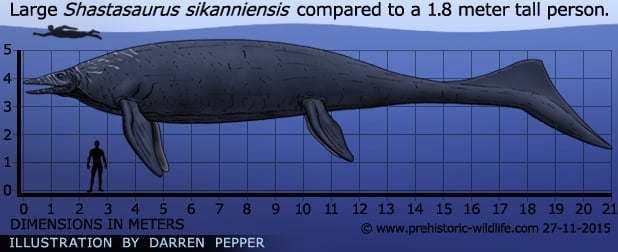
This is the big one, both figuratively and literally.
The largest ichthyosaur was once thought to be Shonisaurus because of a set of unusually large fossils attributed to the genus.
However it was later realised that these fossils actually belonged to another genus named Shastasaurus. Today we now know that the largest individuals of Shastasaurus grew to lengths of at least twenty-one metres.
Aside from being exceptionally large, Shastasaurus was also very specialised.
The jaws were noticeably short, and worked in such a way so that they could be opened very quickly.
The jaws were also toothless which meant that Shastasaurus could only eat soft bodied animals.
Currently thinking has it that Shastasaurus would casually cruise into the depths where it would approach shoals of squid.
It would then open its mouth so quickly that a vacuum would be created inside its mouth, which would then literally suck the squid in.
Such a method of hunting would require very little energy expenditure compared to the more active fish hunting ichthyosaurs, which would free up more calories that could be spent upon growing big.
Honourable mentions
- Utatsusaurus - One of the most primitive ichthyosaurs, and thought to have been one of the first to appear until the description of Cartorhynchus.
- Cymbospondylus - Once thought to have been one of the most predatory of other marine reptiles until the description of Thalattoarchon.
FAQs
When did Ichthyosaurs live?
Ichthyosaurs thrived for an astonishingly long time, from the Early Triassic (about 250 million years ago) to the Late Cretaceous (around 90 million years ago). That’s over 160 million years of ocean domination!
What did Ichthyosaurs eat?
These marine predators weren’t picky when it came to seafood. They dined on fish, squid, and other ocean creatures, snapping them up with their long, toothy snouts.
How big were Ichthyosaurs?
Size-wise, ichthyosaurs were incredibly diverse. Some species were just 3 feet long (1 to 16 meters)—small enough to fit in your living room—while others, like the massive Shonisaurus, stretched over 69 feet (21 meters), rivaling the size of modern whales!
What did Ichthyosaurs look like?
Think of a dolphin or a sleek torpedo, but with reptilian features. Ichthyosaurs had long snouts, massive eyes, paddle-like limbs, and powerful tail fins. Their streamlined bodies were built for speed, making them the Ferraris of the prehistoric oceans.
Did Ichthyosaurs give birth to live young?
Yes, they did! Unlike most reptiles that lay eggs, ichthyosaurs gave birth to live young, a trait that made them perfectly adapted for life in the open seas. Fossils even show tiny ichthyosaurs still inside their mothers!
How fast could Ichthyosaurs swim?
While ichthyosaurs were indeed efficient swimmers, precise speed estimates are challenging to determine from fossil records. Their streamlined bodies suggest they were capable of swift movement.
Why did Ichthyosaurs go extinct?
Ichthyosaurs likely faced competition from other marine reptiles, such as mosasaurs, and struggled with changing ocean environments during the Late Cretaceous, Sea Level Fluctuations. These challenges eventually led to their decline and extinction.
How were Ichthyosaurs discovered?
Mary Anning, along with her brother Joseph, discovered one of the first complete ichthyosaur skeletons around 1811–1812 in Lyme Regis, England.
How did Ichthyosaurs breathe?
Like modern whales and dolphins, ichthyosaurs were air-breathers. They surfaced regularly to fill their lungs before diving back into the depths. Fossil evidence indicates that at least some ichthyosaur species possessed dorsal fins.
What was the largest Ichthyosaur?
The largest known ichthyosaur is Shonisaurus sikanniensis, measuring approximately 21 meters (69 feet) in length.
What are the latest significant ichthyosaur discoveries?
Recent discoveries include a 98-million-year-old ichthyosaur fossil in New Zealand in 2025 and the identification of Ichthyotitan severnensis in the UK in 2024

